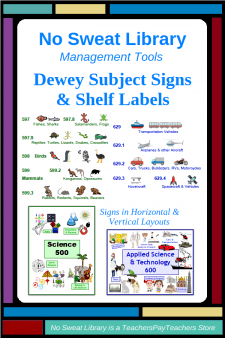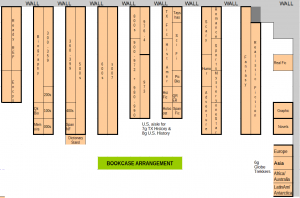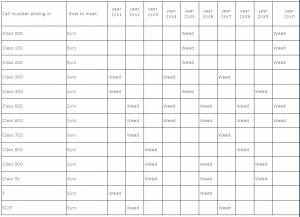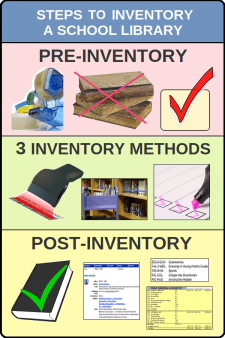 School Librarians strive to create a student-friendly library. For me, this means minimizing the time it takes students to find what they need. Accordingly, I tell them to search the OPAC By Subject and the results will show them the Dewey number for the location of those books. Unfortunately, there’s nothing more frustrating to a student—or to me—than getting a list with several widely different Dewey numbers.
School Librarians strive to create a student-friendly library. For me, this means minimizing the time it takes students to find what they need. Accordingly, I tell them to search the OPAC By Subject and the results will show them the Dewey number for the location of those books. Unfortunately, there’s nothing more frustrating to a student—or to me—than getting a list with several widely different Dewey numbers.
Every one of us, at some point, wonders why a book has a Dewey Decimal Number that places it in a certain location, yet another book on the same topic has a different Dewey number placing it in a different location—sometimes at opposite ends of the library! Should we change the number on one of them? Which one is “correct”? What if there are several books at both—or multiple—locations?
I am not a Dewey purist, so I say we can be flexible with Dewey Decimal Numbers: put a book where students will find it.
IT’S OK TO CHANGE A DEWEY NUMBER
Remember that the Dewey Decimal Classification System was designed to organize knowledge by discipline, that is, by the field of study of those who’d use the information. Library of Congress catalogers use that principle when they assign Dewey numbers for Cataloging-in-Publication (CIP) data, and usually it works fine in our school libraries. But, sometimes the Dewey number for adults working in a field isn’t compatible with the topical curricular needs of our PreK-12 students.
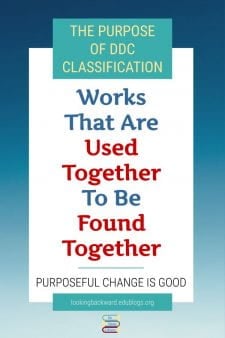 Our young ones look for books by subject or topic, and they expect to find all of them together. I often change a Dewey number to put a book where students will look for it. In fact, changing a Dewey number for student access actually fulfills the very purpose of Dewey Classification: “works that are used together to be found together.” For kids we can take some creative license and redo the numbers on books if they will be more useful in another location.
Our young ones look for books by subject or topic, and they expect to find all of them together. I often change a Dewey number to put a book where students will look for it. In fact, changing a Dewey number for student access actually fulfills the very purpose of Dewey Classification: “works that are used together to be found together.” For kids we can take some creative license and redo the numbers on books if they will be more useful in another location.
I know there are arguments against changing Dewey numbers, but I believe they lack validity. Here’s my reasoning:
- Don’t worry about “the next librarian.” Who of us has memorized DDC numbers past the 10 main classes? The next librarian will be as concerned about student access as we are, and will be grateful that books are where everyone can more easily find them.
- Finding something in a different library? Who remembers the Dewey number of a particular book? A book search will tell them the location of any book in that library. So what if it’s different from ours as long as they can locate it.
- Even professional catalogers may disagree about where a book “belongs.” That’s straight from the cataloging professor when I took the course for my library degree!
- The most compelling argument for making changes is that LOC and OCLC continuously make changes to DDC to meet the changing needs of society. Each new publication of DDC and Abridged DDC has numerous pages of Dewey number additions, deletions, substitutions, and revisions that have been made since the previous publication. Sometimes they’ll change a whole section, like moving pets from the 500s to 600s or travel guides from the 600s to 900s. Dewey is meant to accommodate patron needs.
USEFUL MODIFICATIONS USING DEWEY NUMBERS
For books with multiple subjects, DDC follows the rule of two or rule of three. This means books are assigned to the first, or lowest, Dewey Decimal Number that includes both/all disciplines. If you weren’t aware of this, it may explain why certain books are where they are…especially so many in the 300s!
These 2 rules are particularly annoying when applied to computer books, typically found in 004 and 005. When students are looking for books about computers, they’re thinking of the manufactured physical product. Since the 600s are Applied Science & Technology, that’s where students are more likely to look for it, and since I changed such books. the computer books are checked out much more than they were in the 000s.
 Sometimes it makes sense to group books together in one Dewey class to make them all more accessible. A librarian’s recent LM_NET post asked about David Macaulay’s book “Unbuilding,” a fictional dismantling of the Empire State Building. It was classified in 690 Buildings, but she had 3 books on the construction of the Empire State Building in 974.71, which is the number for the State of New York’s History.
Sometimes it makes sense to group books together in one Dewey class to make them all more accessible. A librarian’s recent LM_NET post asked about David Macaulay’s book “Unbuilding,” a fictional dismantling of the Empire State Building. It was classified in 690 Buildings, but she had 3 books on the construction of the Empire State Building in 974.71, which is the number for the State of New York’s History.
Historians (and perhaps NY students) would expect to find a significant event like ESB in the history of New York State, but who else would? My middle school library had books on buildings (including several by Macaulay) scattered in 300s, 600s, 700s, 900s, even 000s (about libraries!). I changed them all to 690 Buildings where students would more logically find them, and within a few days the shelf was bare…boys saw them and couldn’t check them out fast enough!
HELPFUL ALTERNATE DEWEY NUMBERS
To make a Dewey section more useful for students we may need to make a more extensive alteration of Dewey numbers. One of the first changes I made resulted from an elementary librarian’s suggestion on LM_NET. Few of us have 398.2 Folk literature differentiated between fairy tales, legends, fables, myths, and tall tales, yet that’s how our students study them. There are already Dewey numbers that align with these literary types as a better way to organize folktales. These changes rejuvenated my folktale section, and I’m sure they will do the same for you:
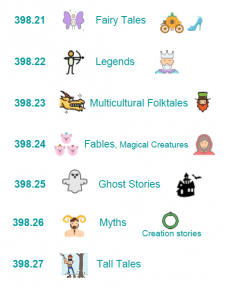 Fairy tales=398.21 Paranatural beings of human/semihuman form
Fairy tales=398.21 Paranatural beings of human/semihuman form- Legends=398.22 Legendary or mythological persons
- Fables=398.24 Plants & animals, real & legendary
- Myths and creation stories=398.26 Physical phenomena
- Tall tales=398.27 Everyday human life, historical/quasi historical events
- Multicultural tales I changed to 398.23 Places and times from 398.2089. That allowed me to reduce 2 decimal numbers then add one back indicating continent of origin according to Table 2 Geographic areas.
Another mess is the 920 Collected biographies. A spine label with 920 and the author’s 3 letters is not user-friendly for anyone, especially not for kids. DDC offers an alternative called Option A, which uses numbers 921-928 to align with main Dewey Classes! I used them to completely redo my 920s. Students loved the change and circulation of those biographies dramatically increased!
CREATIVE ADJUSTMENTS TO DEWEY
 Addictive Substances was a problematic topic for my students because it appears in 3 different Dewey numbers—362.29, 613.8, and 616.86—depending on whether the book is about addiction as a social problem, as personal health & safety, or as a disease. To simplify access for students needing books about drugs, I decided to put all the books in 616.86.
Addictive Substances was a problematic topic for my students because it appears in 3 different Dewey numbers—362.29, 613.8, and 616.86—depending on whether the book is about addiction as a social problem, as personal health & safety, or as a disease. To simplify access for students needing books about drugs, I decided to put all the books in 616.86.
Here’s the “creative” part: For similar drugs the Dewey number additional decimals are wildly different. After careful analysis, I decided to adjust some of the thousandths numbers to create a more consistent grouping of drugs for 616.86. Students immediately noticed the larger drug section, thought I’d purchased new books, and their circulation skyrocketed. Learn more about creative Dewey in my e-Book, available in my TPT store.
LOC and OCLC have begun to make DDC culturally responsive, but School Librarians must be especially responsive to the diversity of students we serve. DDC’s application of expansion numbers for racial, cultural, ethnic, and national groups is inconsistent. In a search for something that could apply across all Dewey numbers, I found that Table 2 Geographic areas lists numbers for the continents that can be added as an identifier. It’s the familiar one added after 9 in the 900s. I decided to use them as “Continent of origin” for cultural and ethnic grouping, so I’ve adjusted and even created numbers in various sections of the school library to overcome Dewey’s racial and cultural biases. You can read more about it in my e-Book!
I applied this “Continent of origin” concept to books in 305.8 Groups of people, 398.23 Multicultural folktales, and 920 Collected biographies. My biggest change was gathering books together to create two completely new sections in 973 U.S. History: 973.04 Multicultural U.S. History and 973.08 Multicultural America about which I’ve written before.
I made other significant changes to 973 U.S. History by removing all the State books except our own, because a) it’s the only one our middle school students study, and b) because more accurate information about states is available online. I kept many topically relevant books found among those state Dewey numbers, and moved them to a better Dewey section, such as putting books about 9-11 in 364.1 Criminal offenses where we have other terrorism books. I also redid the Dewey number into the appropriate time period for timely U.S. history books, like the original colonies and westward expansion.
IS THIS WORTH IT?
 You may be thinking, hey…this is way too much work! I admit, it takes some extra time up front, but just do a little bit at a time—not all of it at once. I typically pull out odd books while shelving, attach a stickie note with the new number, then make changes when I have a few minutes free at the circulation desk. For new books I may have to redo spine labels and cataloging for selected topics, but it doesn’t take that long.
You may be thinking, hey…this is way too much work! I admit, it takes some extra time up front, but just do a little bit at a time—not all of it at once. I typically pull out odd books while shelving, attach a stickie note with the new number, then make changes when I have a few minutes free at the circulation desk. For new books I may have to redo spine labels and cataloging for selected topics, but it doesn’t take that long.
Here are the greatest benefits for changing Dewey numbers:
- It’s easier for students to browse like-topic books, which excites them.
- It’s faster for students to find the books they need, which pleases teachers who seem to think students waste time looking for things in the library.
- It increases circulation, which satisfies our administrators who may think the library is just an add-on.
If changing Dewey Decimal numbers changes people’s minds about our School Library Program, then I believe it is totally worth it!
I hope this has convinced you to make changes to Dewey Decimal numbers on some of your books so they are more accessible for students. There are no “Dewey Police” that come into our library to check number assignments and lock us up for making Dewey changes, so let’s go ahead and DO IT! Our students will thank us, and that’s all the reason I need.
MAKE DEWEY EVEN EASIER WITH SIGNAGE
Even with Dewey number changes, the best way to help kids locate books is better library signage. If you like the above examples of colorful labels I created for my Dewey shelves, you can get Dewey Subject Signs & Shelf Labels in my NoSweat Library store on TPT. Your students, like mine, will enjoy looking at your new signage and discovering topics within the library they hadn’t known about before!
The real key to helping students locate books is teaching them how to locate a decimal number on the shelf. Teaching the DDC is a colossal waste of time. Work with your math teachers to create a hands-on lesson about place value and sequencing. To learn more about this, read my blog post Do We Teach Dewey … or Don’t We? A School Library Lesson.


